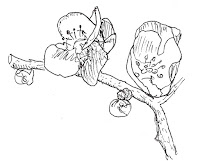 |
| Three pots of stripey early tulips on the patio |
Bulbs are coming up all over the place and it's time to plant. Over 33 years, although always organic, this garden has had many failed plants and many a new think. Now that I am older I don't want to be continually replanting and re-trying so I've decided to grow fewer perennials that hate the clay and more shrubby things that seem to like it. I will introduce more natives and wild flowers for the insects but not to the exclusion of plants that come from afar.
Last year I added an unlikely-looking stick of hawthorn (a rich habitat for all sorts of wildlife), to the hedge which this year has obviously taken (though still just a stick!) and is green with leaves. This year I have chosen two more plants. The first is a native: Euonymus europaeus.
 |
| Very simple flower of Euonymus europaeus |
The wood used to be made into spindles for spinning wool and flax hence its common name, spindle. It is very wildlife friendly. The leaves are eaten by the caterpillars of several moths and the holly blue butterfly and it attracts sparrows and other birds also lacewings and hoverflies. It grows rather tall but can be cut back and in autumn it has astonishing vivid reddish purple fruits with orange berries.
 |
| Euonymus europaeus fruits |
I also chose a red chaenomeles or Japanese quince. because I think they are so attractive and I've already tried and failed twice. It's certainly not a native but it flowers early and for quite a long time, providing nutrients for early bumblebees and other early fliers.
Protecting very new young plants - can you see the spindle?




Comments
Post a Comment